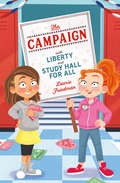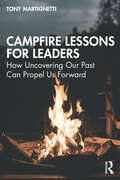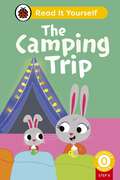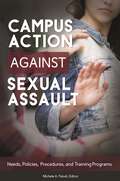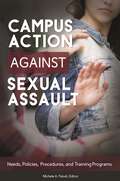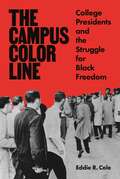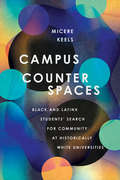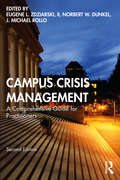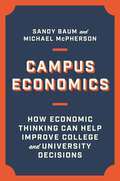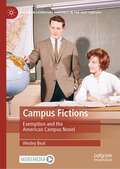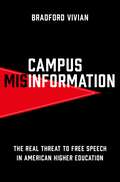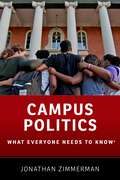- Table View
- List View
The Campaign: With Liberty and Study Hall for All (Untitled Student Council Ser.)
by Laurie FriedmanFor readers interested in social and political justice comes a new middle grade fiction series about student council, elections, and running a fair and honest campaignAmanda Adams has always dreamed of running for class president. Her mom is a member of Congress and her dad is a political strategist who manages her mother's campaigns. Politics is in her DNA. She has the perfect VP in mind for the school ticket: her best friend Meghan Hart. But when Amanda finds out that Meghan has political ambitions of her own, these two best friends suddenly find themselves on opposite sides of the aisle, and, as each girl mounts her campaign, it's clear the gloves are about to come off. As the rest of their classmates begin to choose sides, the girls realize how they carry themselves over the coming weeks will have a lasting impact on the outcome.
Campaigning for “Education for all”: Histories, Strategies and Outcomes of Transnational Advocacy Coalitions in Education
by Antoni Verger Mario NovelliCivil society organizations have risen up the global education agenda since the international community adhered to the 'Education For All' Action Framework in the 'World Education Forum' that was held in Dakar in 2000. With the foundation of the Global Campaign for Education (GCE) civil society advocacy has sought to ensure that national governments, donors and international organisations make the necessary efforts to guarantee quality education for all children in the world. This book explores the strategies and actions, as well as the challenges and impact of civil society organizations in the achievement of the 'Education For All' international commitments. It does so by specifically focusing on seven national coalitions affiliated to the GCE. From Africa, to Asia to Latin America the book shows how these coalitions work and manage the differences between their different types of constituencies, explores their varied tactics and strategies, and explains their successes and failures after more than a decade of coordinated action. The book also provides a concise and comprehensive synthesis of findings from the distinct case studies and offers a series of lessons learned that are vital for education practitioners, academics, activists and policy-makers committed to more equitable and relevant education systems around the world.
Campfire Lessons for Leaders: How Uncovering Our Past Can Propel Us Forward
by Tony MartignettiThis ideal companion for business leaders heading into a milestone moment offers practical advice to help them take something that can seem amorphous and abstract – living an intentional, purposeful life – and turn it into reality. Though it might seem counterintuitive, this book demonstrates that to move forward in the right direction, you must understand and integrate your past into your present. Readers will see how they too can step back and consider the "flashpoints" of their past in a way that will serve them as they take the next step of their life, from navigating a significant life change to simply living each day feeling less stuck and more purposeful. Leading coach Tony Martignetti shares the most powerful lessons from over 200 "Virtual Campfire" podcast interviews he’s conducted with driven individuals who decided to live intentionally rather than by default. As no two interviewees have faced the same challenges or pursued the same goals, readers will be inspired by these diverse insights to embark on – and sustain – their own unique transformations. Packed with questions, journaling prompts, and real-world exercises to help readers understand their past at a deeper level and integrate it into their present, this book provides a valuable toolkit for business leaders and professionals in any industry who feel unfulfilled and uncertain about what’s next for them.
Campfire Lessons for Leaders: How Uncovering Our Past Can Propel Us Forward
by Tony MartignettiThis ideal companion for business leaders heading into a milestone moment offers practical advice to help them take something that can seem amorphous and abstract – living an intentional, purposeful life – and turn it into reality. Though it might seem counterintuitive, this book demonstrates that to move forward in the right direction, you must understand and integrate your past into your present. Readers will see how they too can step back and consider the "flashpoints" of their past in a way that will serve them as they take the next step of their life, from navigating a significant life change to simply living each day feeling less stuck and more purposeful. Leading coach Tony Martignetti shares the most powerful lessons from over 200 "Virtual Campfire" podcast interviews he’s conducted with driven individuals who decided to live intentionally rather than by default. As no two interviewees have faced the same challenges or pursued the same goals, readers will be inspired by these diverse insights to embark on – and sustain – their own unique transformations. Packed with questions, journaling prompts, and real-world exercises to help readers understand their past at a deeper level and integrate it into their present, this book provides a valuable toolkit for business leaders and professionals in any industry who feel unfulfilled and uncertain about what’s next for them.
The Camping Trip (Read It Yourself)
by LadybirdTwo stories that build on the phonics learned in previous steps and focus on the sound and letter combinations: igh, ear, air, ure.The Camping Trip is from Beginner Reader Level 0 and is ideal for children aged from 4+ who are developing their phonics and early reading skills.Each book has been carefully checked by educational and subject consultants and includes comprehension puzzles, book band information, and tips for helping children with their reading.With five levels to take children from first phonics to fluent reading and a wide range of different stories and topics for every interest, Read It Yourself helps children build their confidence and begin reading for pleasure.
Campus Action against Sexual Assault: Needs, Policies, Procedures, and Training Programs (Women's Psychology)
by Michele A. PaludiA practical guide to prevention of and response to sexual assault on college campuses, this invaluable resource will help ensure Title IX compliance—and can also help reduce the incidence of these all-too-prevalent events.The frequency of sexual assault on college campuses is startlingly high. Notwithstanding this fact, most campus officials are not trained in the psychology of the victimization process, while most students are not aware of their reporting options. A practical guide to sexual assault at colleges and universities, this book integrates theories and empirical research with information about legislation and techniques to help college administrators deal with—and prevent—these disturbing offenses. The work brings together a team of experts who discuss various types of assault, including rape, stalking, intimate partner violence, and sexual harassment, and detail the legal, educational, and federal responses to such events on college campuses. They address federal and state laws, including new bills being proposed in Congress, and present research on the physical and psychological dimensions of sexual assault. Perhaps most important, the book shows how human resource techniques and principles can be used to establish preventative measures and to respond appropriately when sexual assault does occur. Students' accounts of prevention training and education enhance the scholarly and legal contributions to this important—and timely—volume.
Campus Action against Sexual Assault: Needs, Policies, Procedures, and Training Programs (Women's Psychology)
by Michele A. PaludiA practical guide to prevention of and response to sexual assault on college campuses, this invaluable resource will help ensure Title IX compliance—and can also help reduce the incidence of these all-too-prevalent events.The frequency of sexual assault on college campuses is startlingly high. Notwithstanding this fact, most campus officials are not trained in the psychology of the victimization process, while most students are not aware of their reporting options. A practical guide to sexual assault at colleges and universities, this book integrates theories and empirical research with information about legislation and techniques to help college administrators deal with—and prevent—these disturbing offenses. The work brings together a team of experts who discuss various types of assault, including rape, stalking, intimate partner violence, and sexual harassment, and detail the legal, educational, and federal responses to such events on college campuses. They address federal and state laws, including new bills being proposed in Congress, and present research on the physical and psychological dimensions of sexual assault. Perhaps most important, the book shows how human resource techniques and principles can be used to establish preventative measures and to respond appropriately when sexual assault does occur. Students' accounts of prevention training and education enhance the scholarly and legal contributions to this important—and timely—volume.
The Campus Color Line: College Presidents and the Struggle for Black Freedom
by Eddie R. Cole"A stunning and ambitious origins story."—Ibram X. Kendi, National Book Award–winning and #1 New York Times–bestselling authorThe remarkable history of how college presidents shaped the struggle for racial equalitySome of America’s most pressing civil rights issues—desegregation, equal educational and employment opportunities, housing discrimination, and free speech—have been closely intertwined with higher education institutions. Although it is commonly known that college students and other activists, as well as politicians, actively participated in the fight for and against civil rights in the middle decades of the twentieth century, historical accounts have not adequately focused on the roles that the nation’s college presidents played in the debates concerning racism. Based on archival research conducted at a range of colleges and universities across the United States, The Campus Color Line sheds light on the important place of college presidents in the struggle for racial parity.Focusing on the period between 1948 and 1968, Eddie Cole shows how college presidents, during a time of violence and unrest, strategically, yet often silently, initiated and shaped racial policies and practices inside and outside of the educational sphere. With courage and hope, as well as malice and cruelty, college presidents positioned themselves—sometimes precariously—amid conflicting interests and demands. Black college presidents challenged racist policies as their students demonstrated in the streets against segregation, while presidents of major universities lobbied for urban renewal programs that displaced Black communities near campus. Some presidents amended campus speech practices to accommodate white supremacist speakers, even as other academic leaders developed the nation’s first affirmative action programs in higher education.The Campus Color Line illuminates how the legacy of academic leaders’ actions continues to influence the unfinished struggle for Black freedom and racial equity in education and beyond.
Campus Counterspaces: Black and Latinx Students' Search for Community at Historically White Universities
by Micere KeelsFrustrated with the flood of news articles and opinion pieces that were skeptical of minority students' "imagined" campus microaggressions, Micere Keels, a professor of comparative human development, set out to provide a detailed account of how racial-ethnic identity structures Black and Latinx students' college transition experiences.Tracking a cohort of more than five hundred Black and Latinx students since they enrolled at five historically white colleges and universities in the fall of 2013 Campus Counterspaces finds that these students were not asking to be protected from new ideas. Instead, they relished exposure to new ideas, wanted to be intellectually challenged, and wanted to grow. However, Keels argues, they were asking for access to counterspaces—safe spaces that enable radical growth. They wanted counterspaces where they could go beyond basic conversations about whether racism and discrimination still exist. They wanted time in counterspaces with likeminded others where they could simultaneously validate and challenge stereotypical representations of their marginalized identities and develop new counter narratives of those identities.In this critique of how universities have responded to the challenges these students face, Keels offers a way forward that goes beyond making diversity statements to taking diversity actions.
Campus Crisis Management: A Comprehensive Guide for Practitioners
by Eugene L. Zdziarski Norbert W. Dunkel J. Michael RolloCampus Crisis Management is a practical resource that helps campus administrators evaluate, revise, or establish a comprehensive crisis management plan appropriate for their college or university. Filled with examples, assessment tools, and checklists, this book describes the individuals who should be involved in developing a campus plan, what a plan should include, as well as a variety of crisis events and issues that should be addressed in a comprehensive crisis management plan. Including contributions from renowned practitioners at all levels, this fully revised, new edition contains the must-have information on crisis management, such as: How to develop a comprehensive crisis management system The different types of crises using the crisis matrix The structure, operation, and training of a crisis team Strategies for working with the media New chapters addressing behavioral intervention teams, active shooter situations, Title IX guidance, campus demonstrations, outbreaks of infectious and contagious diseases, and special event management. From a senior administrator working with an institution-wide emergency operations team, to a new professional looking to develop plans and protocols to respond to critical incidents, Campus Crisis Management is a comprehensive guide to planning and preparing for campus emergencies of any scale.
Campus Crisis Management: A Comprehensive Guide for Practitioners
by Eugene L. Zdziarski II Norbert W. Dunkel J. Michael RolloCampus Crisis Management is a practical resource that helps campus administrators evaluate, revise, or establish a comprehensive crisis management plan appropriate for their college or university. Filled with examples, assessment tools, and checklists, this book describes the individuals who should be involved in developing a campus plan, what a plan should include, as well as a variety of crisis events and issues that should be addressed in a comprehensive crisis management plan. Including contributions from renowned practitioners at all levels, this fully revised, new edition contains the must-have information on crisis management, such as: How to develop a comprehensive crisis management system The different types of crises using the crisis matrix The structure, operation, and training of a crisis team Strategies for working with the media New chapters addressing behavioral intervention teams, active shooter situations, Title IX guidance, campus demonstrations, outbreaks of infectious and contagious diseases, and special event management. From a senior administrator working with an institution-wide emergency operations team, to a new professional looking to develop plans and protocols to respond to critical incidents, Campus Crisis Management is a comprehensive guide to planning and preparing for campus emergencies of any scale.
Campus Diversity Triumphs: Valleys of Hope (Diversity in Higher Education #20)
by Sherwood ThompsonToday's Chief Diversity Officers face tremendous challenges. Among those are threats to Affirmative Action admissions and financial aid programs, the dearth of faculty and staff of color in Predominantly White Institutions, the scarcity of funds to carry out institutional diversity mandates, and the need to play mentor to a vast array of individuals--faculty, staff, students and community stakeholders--with minimum staff support. This book addresses how these and other challenges are tackled by providing valuable insight into the innovative work that Chief Diversity Officers perform. It provides insightful accounts into the diversity program successes and promising practices by diversity officers working on college and university campuses in the United States. Contributors draw upon their experiences as educators working to sustain diversity, inclusion, multiculturalism, and social justice on college campuses and describe how they have designed successful diversity and inclusive excellence initiatives which had a profound positive impact on all demographic populations.
Campus Diversity Triumphs: Valleys of Hope (Diversity in Higher Education #20)
by Sherwood ThompsonToday's Chief Diversity Officers face tremendous challenges. Among those are threats to Affirmative Action admissions and financial aid programs, the dearth of faculty and staff of color in Predominantly White Institutions, the scarcity of funds to carry out institutional diversity mandates, and the need to play mentor to a vast array of individuals--faculty, staff, students and community stakeholders--with minimum staff support. This book addresses how these and other challenges are tackled by providing valuable insight into the innovative work that Chief Diversity Officers perform. It provides insightful accounts into the diversity program successes and promising practices by diversity officers working on college and university campuses in the United States. Contributors draw upon their experiences as educators working to sustain diversity, inclusion, multiculturalism, and social justice on college campuses and describe how they have designed successful diversity and inclusive excellence initiatives which had a profound positive impact on all demographic populations.
Campus Economics: How Economic Thinking Can Help Improve College and University Decisions
by Sandy Baum Michael McPhersonAn invaluable primer on the role economic reasoning plays in campus debate and decision makingCampus Economics provides college and university administrators, trustees, and faculty with an essential understanding of how college finances actually work. Sandy Baum and Michael McPherson explain the concepts needed to analyze the pros, the cons, and the trade-offs of difficult decisions, and offer a common language for discussing the many challenges confronting institutions of higher learning today, from COVID-19 to funding cuts and declining enrollments.Emphasizing the unique characteristics of the academic enterprise and the primacy of the institutional mission, Baum and McPherson use economic concepts such as opportunity cost and decisions at the margin to facilitate conversations about how best to ensure an institution’s ongoing success. The problems facing higher education are more urgent than ever before, but the underlying issues are the same in good times and bad. Baum and McPherson give nontechnical, user-friendly guidance for navigating all kinds of economic conditions and draw on real-world examples of campus issues to illustrate both institutional constraints and untapped opportunities.Campus Economics helps faculty, administrators, trustees, and government policymakers engage in constructive dialogue that can lead to decisions that align finite resources with the pursuit of the institutional mission.
Campus Economics: How Economic Thinking Can Help Improve College and University Decisions
by Sandy Baum Michael McPhersonAn invaluable primer on the role economic reasoning plays in campus debate and decision makingCampus Economics provides college and university administrators, trustees, and faculty with an essential understanding of how college finances actually work. Sandy Baum and Michael McPherson explain the concepts needed to analyze the pros, the cons, and the trade-offs of difficult decisions, and offer a common language for discussing the many challenges confronting institutions of higher learning today, from COVID-19 to funding cuts and declining enrollments.Emphasizing the unique characteristics of the academic enterprise and the primacy of the institutional mission, Baum and McPherson use economic concepts such as opportunity cost and decisions at the margin to facilitate conversations about how best to ensure an institution’s ongoing success. The problems facing higher education are more urgent than ever before, but the underlying issues are the same in good times and bad. Baum and McPherson give nontechnical, user-friendly guidance for navigating all kinds of economic conditions and draw on real-world examples of campus issues to illustrate both institutional constraints and untapped opportunities.Campus Economics helps faculty, administrators, trustees, and government policymakers engage in constructive dialogue that can lead to decisions that align finite resources with the pursuit of the institutional mission.
Campus Fictions: Exemption and the American Campus Novel (American Literature Readings in the 21st Century)
by Wesley BealCampus Fictions argues that the academic novel balances utopian and regressive tendencies, reinforcing the crises we face in higher learning while simultaneously signposting hope for a worn institution. Whether a bestseller such as Erich Segal ’s romance Love Story (1970) or wonkier fare such as Don DeLillo’s White Noise (1985), the academic novel mystifies the academy not only to a wide public but also—worse—to readers who might describe themselves as sympathetic to higher learning. The book takes an eclectic approach to the academic novel with chapters discussing, for example, the genre’s rampant anti-intellectualism and its work refusals, studying novels such as Ishmael Reed’s Japanese by Spring (1993) and Julie Schumacher’s Dear Committee Members (2014). The book is also accompanied by the “Directory of the American Campus Novel ” file, which tracks the genre by year, by setting, and by other datapoints that readers might make use of. Responding directly to Jeffrey Williams, the renowned scholar of critical university studies who implores faculty to “teach the university,” the book ’s conclusion describes strategies for putting these novels into circulation in the classroom. Through this breadth, Campus Fictions establishes the importance of maintaining hope in the field of critical university studies, which tends toward apocalypticism and perhaps therefore toward disengagement.
Campus Free Speech: A Pocket Guide
by Cass R. SunsteinFrom renowned legal scholar Cass R. Sunstein, a concise, case-by-case guide to resolving free-speech dilemmas at colleges and universities.Free speech is indispensable on college campuses: allowing varied views and frank exchanges of opinion is a core component of the educational enterprise and the pursuit of truth. But free speech does not mean a free-for-all. The First Amendment prohibits “abridging the freedom of speech,” yet laws against perjury or bribery, for example, are still constitutional. In the same way, valuing freedom of speech does not stop a university from regulating speech when doing so is necessary for its educational mission. So where is the dividing line? How can we distinguish reasonable restrictions from impermissible infringement?In this pragmatic, no-nonsense explainer, Cass Sunstein takes us through a wide range of scenarios involving students, professors, and administrators. He discusses why it’s consistent with the First Amendment to punish students who shout down a speaker, but not those who chant offensive slogans; why a professor cannot be fired for writing a politically charged op-ed, yet a university might legitimately consider an applicant’s political views when deciding whether to hire her. He explains why private universities are not legally bound by the First Amendment yet should, in most cases, look to follow it. And he addresses the thorny question of whether a university should officially take sides on public issues or deliberately keep the institution outside the fray.At a time when universities are assailed on free-speech grounds from both left and right, Campus Free Speech: A Pocket Guide is an indispensable resource for cutting through the noise and understanding the key issues animating the debates.
Campus Life: Undergraduate Cultures from the End of the Eighteenth Century to the Present
by Helen Lefkowitz Horowitz"Based on subtle, imaginative readings of autobiographies, memoirs, fiction and secondary sources, [Campus Life] tells the story of the changing mentalities of American undergraduates over two centuries."—Michael Moffatt, New York Times Book Review
Campus Misinformation: The Real Threat to Free Speech in American Higher Education
by Bradford VivianAn incisive examination of how pundits and politicians manufactured the campus free speech crisis--and created a genuine challenge to academic freedom in the process. If we listen to the politicians and pundits, college campuses have become fiercely ideological spaces where students unthinkingly endorse a liberal orthodoxy and forcibly silence anyone who dares to disagree. These commentators lament the demise of free speech and academic freedom. But what is really happening on college campuses? Campus Misinformation shows how misinformation about colleges and universities has proliferated in recent years, with potentially dangerous results. Popular but highly misleading claims about a so-called free speech crisis and a lack of intellectual diversity on college campuses emerged in the mid-2010s and continue to shape public discourse about higher education across party lines. Such disingenuous claims impede constructive deliberation about higher learning while normalizing suspect ideas about First Amendment freedoms and democratic participation. Taking a non-partisan approach, Bradford Vivian argues that reporting on campus culture has grossly exaggerated the importance and representativeness of a small number of isolated events; misleadingly advocated for an artificial parity between liberals and conservatives as true viewpoint diversity; mischaracterized the use of trigger warnings and safe spaces; and purposefully confused critique and protest with censorship and "cancel culture." Organizations and think tanks generate pseudoscientific data to support this discourse, then advocate for free speech in highly specific ways that actually limit speech in general. In the name of free speech and viewpoint diversity, we now see restrictions on the right to protest and laws banning certain books, theories, and subjects from schools. By deconstructing the political and rhetorical development of the free speech crisis, Vivian not only provides a powerful corrective to contemporary views of higher education, but provides a blueprint for readers to identify and challenge misleading language--and to understand the true threats to our freedoms.
Campus Misinformation: The Real Threat to Free Speech in American Higher Education
by Bradford VivianAn incisive examination of how pundits and politicians manufactured the campus free speech crisis--and created a genuine challenge to academic freedom in the process. If we listen to the politicians and pundits, college campuses have become fiercely ideological spaces where students unthinkingly endorse a liberal orthodoxy and forcibly silence anyone who dares to disagree. These commentators lament the demise of free speech and academic freedom. But what is really happening on college campuses? Campus Misinformation shows how misinformation about colleges and universities has proliferated in recent years, with potentially dangerous results. Popular but highly misleading claims about a so-called free speech crisis and a lack of intellectual diversity on college campuses emerged in the mid-2010s and continue to shape public discourse about higher education across party lines. Such disingenuous claims impede constructive deliberation about higher learning while normalizing suspect ideas about First Amendment freedoms and democratic participation. Taking a non-partisan approach, Bradford Vivian argues that reporting on campus culture has grossly exaggerated the importance and representativeness of a small number of isolated events; misleadingly advocated for an artificial parity between liberals and conservatives as true viewpoint diversity; mischaracterized the use of trigger warnings and safe spaces; and purposefully confused critique and protest with censorship and "cancel culture." Organizations and think tanks generate pseudoscientific data to support this discourse, then advocate for free speech in highly specific ways that actually limit speech in general. In the name of free speech and viewpoint diversity, we now see restrictions on the right to protest and laws banning certain books, theories, and subjects from schools. By deconstructing the political and rhetorical development of the free speech crisis, Vivian not only provides a powerful corrective to contemporary views of higher education, but provides a blueprint for readers to identify and challenge misleading language--and to understand the true threats to our freedoms.
Campus Politics: What Everyone Needs to Know® (What Everyone Needs To Know®)
by Jonathan ZimmermanUniversities are usually considered bastions of the free exchange of ideas, but a recent tide of demonstrations across college campuses has called this belief into question, and with serious consequences. Such a wave of protests hasn't been seen since the campus free speech demonstrations of the 1960s, yet this time it is the political Left, rather than the political Right, calling for restrictions on campus speech and freedom. And, as Jonathan Zimmerman suggests, recent campus controversies have pitted free speech against social justice ideals. The language of trauma--and, more generally, of psychology--has come to dominate campus politics, marking another important departure from prior eras. This trend reflects an increased awareness of mental health in American society writ large. But it has also tended to dampen exchange and discussion on our campuses, where faculty and students self-censor for fear of insulting or offending someone else. Or they attack each other in periodic bursts of invective, which run counter to the "civility" promised by new speech and conduct codes. In Campus Politics: What Everyone Needs to Know®, Jonathan Zimmerman breaks down the dynamics of what is actually driving this recent wave of discontent. After setting recent events in the context of the last half-century of free speech campus movements, Zimmerman looks at the political beliefs of the US professorate and students. He follows this with chapters on political correctness; debates over the contested curriculum; admissions, faculty hires, and affirmative action; policing students; academic freedom and censorship; in loco parentis administration; and the psychology behind demands for "trigger warnings" and "safe spaces." He concludes with the question of how to best balance the goals of social and racial justice with the commitment to free speech.
CAMPUS POLITICS WENK C: What Everyone Needs to Know® (What Everyone Needs To Know®)
by Jonathan ZimmermanUniversities are usually considered bastions of the free exchange of ideas, but a recent tide of demonstrations across college campuses has called this belief into question, and with serious consequences. Such a wave of protests hasn't been seen since the campus free speech demonstrations of the 1960s, yet this time it is the political Left, rather than the political Right, calling for restrictions on campus speech and freedom. And, as Jonathan Zimmerman suggests, recent campus controversies have pitted free speech against social justice ideals. The language of trauma--and, more generally, of psychology--has come to dominate campus politics, marking another important departure from prior eras. This trend reflects an increased awareness of mental health in American society writ large. But it has also tended to dampen exchange and discussion on our campuses, where faculty and students self-censor for fear of insulting or offending someone else. Or they attack each other in periodic bursts of invective, which run counter to the "civility" promised by new speech and conduct codes. In Campus Politics: What Everyone Needs to Know®, Jonathan Zimmerman breaks down the dynamics of what is actually driving this recent wave of discontent. After setting recent events in the context of the last half-century of free speech campus movements, Zimmerman looks at the political beliefs of the US professorate and students. He follows this with chapters on political correctness; debates over the contested curriculum; admissions, faculty hires, and affirmative action; policing students; academic freedom and censorship; in loco parentis administration; and the psychology behind demands for "trigger warnings" and "safe spaces." He concludes with the question of how to best balance the goals of social and racial justice with the commitment to free speech.
Campus Power Struggle
by Michael SherradenCampus Power Struggle traces the explosive evolution of the student political movement from the Berkeley Free Speech Movement of 1964 to armed confrontation at Cornell in 1969. From campus conflict as a microcosm of larger political struggles for self-determination, to student concern about infringements upon personal liberties, the studies in this book provide authoritative insight into unrest on American campuses. This volume represents sociology as the ""big news"" in its most impressive and involved style. No.l in the series.Contents: Introduction - The Struggle for Power on the Campus (Howard S. Becker). Beyond Berkeley (Joseph Gusfleld). Columbia: The Dynamics of a Student Revolution (Ellen Kay Tnmberger). The Crisis at San Francisco State (James McEvoy and Abraham Miller). Confrontation at Cornell (William H. Fried/and and Harry Edwards'). The Phantom Racist (Rita James Simon and James Carey). Dynamic Young Fogies-Rebels on the Right (Lawrence F. Schiff). Ending Campus Drug Incidents (Howard S. Becker). The Psychiatrist as Double Agent (Thomas Szasz). Student Power in Action (Arlie Hochschild).
Campus Power Struggle
by Michael SherradenCampus Power Struggle traces the explosive evolution of the student political movement from the Berkeley Free Speech Movement of 1964 to armed confrontation at Cornell in 1969. From campus conflict as a microcosm of larger political struggles for self-determination, to student concern about infringements upon personal liberties, the studies in this book provide authoritative insight into unrest on American campuses. This volume represents sociology as the ""big news"" in its most impressive and involved style. No.l in the series.Contents: Introduction - The Struggle for Power on the Campus (Howard S. Becker). Beyond Berkeley (Joseph Gusfleld). Columbia: The Dynamics of a Student Revolution (Ellen Kay Tnmberger). The Crisis at San Francisco State (James McEvoy and Abraham Miller). Confrontation at Cornell (William H. Fried/and and Harry Edwards'). The Phantom Racist (Rita James Simon and James Carey). Dynamic Young Fogies-Rebels on the Right (Lawrence F. Schiff). Ending Campus Drug Incidents (Howard S. Becker). The Psychiatrist as Double Agent (Thomas Szasz). Student Power in Action (Arlie Hochschild).
Campus Service Workers Supporting First-Generation Students: Informal Mentorship and Culturally Relevant Support as Key to Student Retention and Success (Routledge Research in Higher Education)
by Georgina Guzmán LaTonya Rease Miles Stephanie Santos YoungbloodThis unique collection of testimonials, critical essays, and first-hand accounts demonstrates the significant contribution of campus service workers in supporting the retention and success of first-generation college students. Using a Freirean framework to ground individual stories, the text identifies ways in which campus workers connect with students, provide informal mentorship, and offer culturally relevant support during students’ transition to college and beyond. Drawing on a range of interviews, case studies, and research studies, emphasis is placed on the unique challenges faced by first-generation and minority students such as cultural alienation, imposter syndrome, language barriers, and financial insecurity. Ultimately, the text dismantles notions of social hierarchies that separate workers and college students and encourages institutions to invest in these workers and their contribution to student well-being and success. This book will benefit researchers, academics, and educators with an interest in the higher education and student affair practice and higher education administration more broadly. Those specifically interested in multicultural education and the study of race and ethnicity within US higher educational contexts will also benefit from this book.
